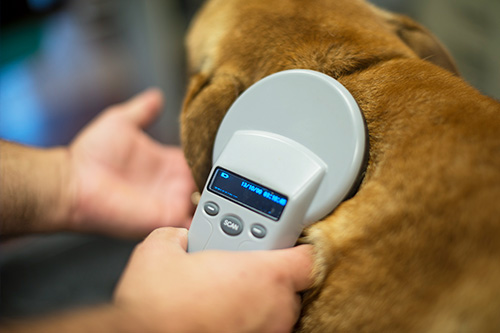
Imagine if your dog or cat got lost. You’d want to give him or her the best chance of getting home. With microchipping, you can.
Microchipping is a safe, permanent way to identify your pet in case he or she becomes lost. A microchip, which is a tiny device about the size and shape of a grain of rice, is placed just under the loose skin at the back of the neck. When a lost dog or cat without an ID tag is found, a veterinarian or veterinary technician will use a handheld microchip scanner to check for a chip. If the pet has one, it will transmit its ID number to the scanner via a low-frequency radio wave. The veterinary hospital or shelter then calls the chip manufacturer, retrieves the pet owner’s contact information, and calls the owner.
Even the most responsible pet owners can’t always guarantee their pets won’t get lost. A leash could break or slip out of your hand, a pet could push through a screen door or window, or a contractor or friend might accidentally leave a door or gate open.
We recommend that you use a microchip, along with a collar and ID tag, to identify your pet. An ID tag is still a reliable identification method. Pets that have tags with current contact information are more likely to not end up in shelters and tend to get home faster than those without tags. However, collars and ID tags aren’t permanent and can be removed (overnight or for grooming); pets can also lose them. With a microchip, your pet will have a much better chance of being identified and returned to you. Pets without microchips that end up in shelters may be adopted out to another family or even euthanized.
Please contact us to schedule an appointment to microchip your pet. Although we hope your pet never becomes lost, we want you to be prepared. We can also suggest a plan to have in place so if your pet does go missing, you’ll be able to act quickly.
We can microchip ferrets, rabbits, birds, and other companion animals, too!
Imagine que su perro o gato se pierde. Seguramente querría darle la mejor oportunidad de regresar a casa. Con un microchip, puede hacerlo.
El microchip es una forma segura y permanente de identificar a su mascota en caso de que se extravíe. Es un dispositivo diminuto, del tamaño de un grano de arroz, que se coloca bajo la piel suelta en la parte posterior del cuello. Si un perro o gato perdido sin placa de identificación es encontrado, un veterinario o técnico veterinario utilizará un escáner de microchips para verificar si tiene uno. Si lo tiene, el microchip transmitirá su número de identificación al escáner mediante una onda de radio de baja frecuencia. El hospital veterinario o refugio contactará al fabricante del chip para obtener la información del propietario y llamarlo de inmediato.
Incluso los dueños de mascotas más responsables no pueden garantizar que su mascota nunca se perderá. Un correa podría romperse, una mascota podría escaparse por una puerta o ventana abierta, o alguien podría dejar accidentalmente una puerta o portón sin cerrar.
Recomendamos usar un microchip junto con un collar e identificación. Aunque una placa de identificación con información actualizada sigue siendo un método confiable, los collares y etiquetas no son permanentes y pueden perderse o ser removidos. Con un microchip, su mascota tendrá una mayor probabilidad de ser identificada y devuelta a su hogar. Las mascotas sin microchip que terminan en refugios pueden ser adoptadas por otra familia o incluso ser sacrificadas.
Contáctenos para programar una cita y colocar un microchip a su mascota. Aunque esperamos que nunca se pierda, queremos que esté preparado. También podemos ayudarle a crear un plan de acción para actuar rápidamente si su mascota se extravía.
¡También microchipeamos hurones, conejos, aves y otras mascotas de compañía!

